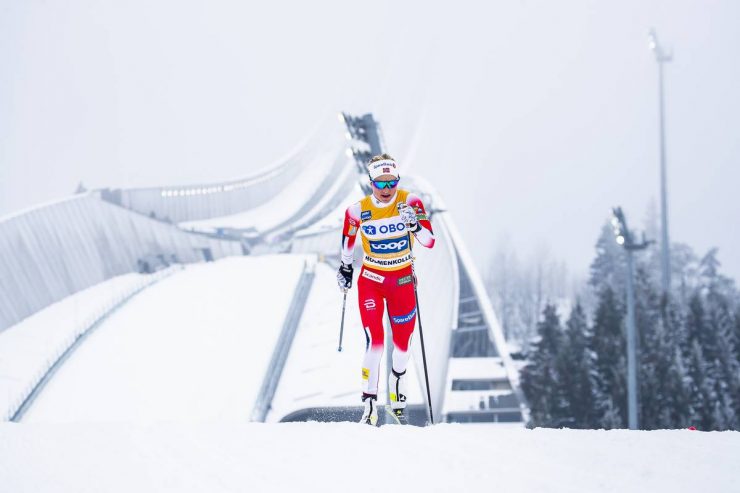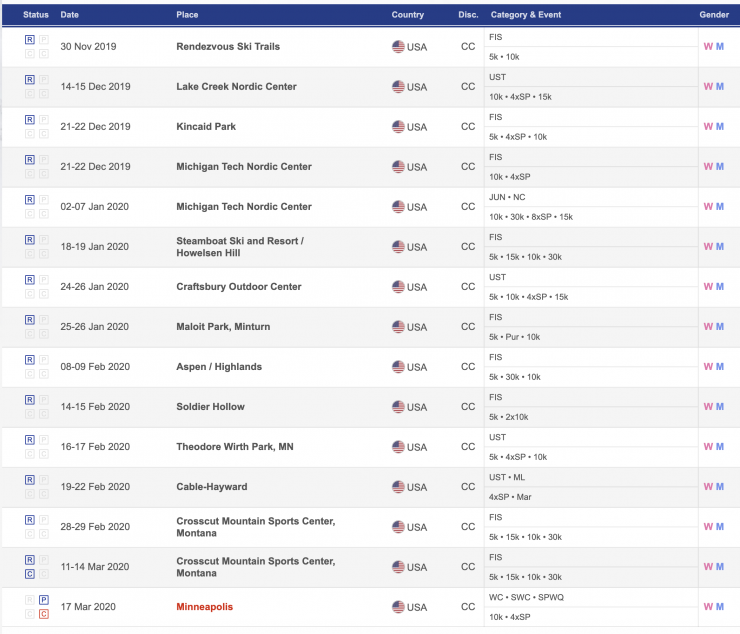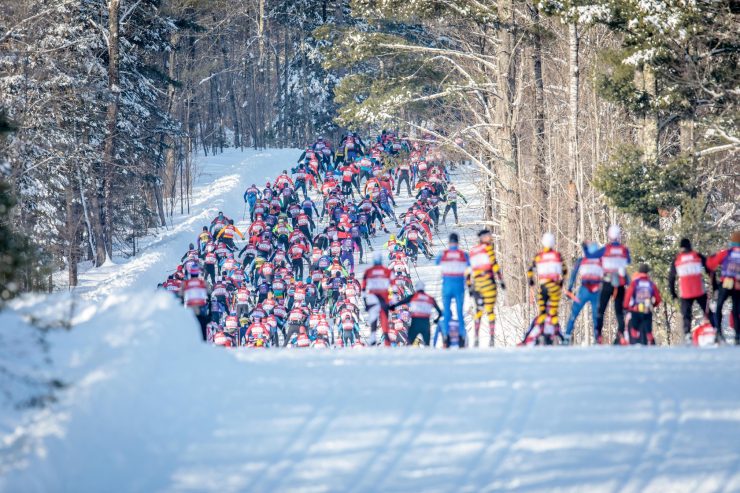
First in a two-part series. Coming next week: The meaning of a single FIS point for national team selection.
The recent news that David Norris was not named to the national team by the narrowest of margins, following the application of objective selection criteria tied to an athlete’s position on an overall FIS points world ranking list, has inspired FasterSkier to take a closer look at where these numbers come from. The goal of this piece is to provide some background on the mathematical inputs for this magic number, and to survey some of the things it is used for.
Where FIS points come from
First things first: FIS is an abbreviation for Fédération Internationale de Ski, the French term for the Switzerland-based International Ski Federation. FIS is an international governing body that sets international competition rules for a range of snow sports. It has a membership of 118 national ski associations.
There were a great many ski races in this country in the winter of 2019–2020. A relatively small portion were sanctioned by U.S. Ski & Snowboard (formerly and still better-known as USSA), the domestic governing body for American skiing, and were tied to the National Rankings List, or NRL. If you raced at Junior Nationals this year, for example, you got NRL points but not FIS points.
An even smaller portion of domestic races last year were FIS races, meaning that they would provide FIS points to competing athletes who had an active FIS license. Here is the entire list of FIS races in this country last season (to clarify, clicking on this list on the FIS website yields multiple races for each venue, such as a men’s and women’s distance race, sprint qualifier, and sprint heats for the second entry, the Sun Valley SuperTour stop):

Yes, that’s poignantly missing a certain mid-March domestic World Cup stop (listed in red to show it was cancelled), and technically speaking the March entry for Montana has fewer results than it should because NCAA Championships were cancelled halfway through, but this is otherwise a complete list. It contains U.S. Nationals, standalone SuperTour stops, December JOQ races in Alaska and Michigan, and regular-season races for the RMISA college circuit, but not for CCSA or EISA. Add a November race at West Yellowstone, and that’s a total of 14 FIS race stops, for the entire country, for the entire winter. Not too many.
Designating a race as an official FIS race involves paying an additional fee to FIS, as well as other logistical requirements aimed at ensuring the fairness of the competition and the accuracy of the results. Most fundamentally, it requires hosting the race on a homologated course, that is, a race course that meets numerous requirements for specifications like width, overall climb, and the placement of hills. You can find more information about the homologation process here, and a very long article about the earliest FIS race in each season here.
(All that said, FIS points may also be awarded for a race that was intended to be held on a homologated course, but was moved due to safety considerations. The distance races at 2018 U.S. Nationals in Anchorage, distance races at 2014 Spring Series in Anchorage, and the infamous 33-lap 50 km at 2012 Spring Series at Craftsbury are just some of many examples. FIS points are also awarded for city sprints, including those on virtually flat courses that would not meet a typical sprint course homologation standard.)
How FIS points are calculated
The following should be clear as mud:

Seriously, though, this may look daunting – and the German may not help – but the math, and the concept behind it, are both pretty straightforward. Briefly put, it’s a calculation of an individual racer’s percentage back from the race winner (as measured by time, not by placing), multiplied by a factor that approximates how tightly bunched the field is expected to be.
As an example, say someone wins an interval-start 5 k race in 14 minutes (840 seconds), and you finish second in 15 minutes (900 seconds). Using the righthand calculation from the screenshot above, 900/840 is, in round numbers, 1.0714. (Put another way, you finished 7.14% back from the winner.) Subtract 1, and you get 0.0714. Multiply that by the race factor, in this case 800 for an interval-start race, and you get 57.12. Your race points for this race are 57.12. That’s it. (At least if this is a World Cup-level race, so you don’t have to do additional steps to account for the relative strength of the field. More on that later.)
For one more example: Say it’s a mass start race, and you stay in the lead pack till the very end, but then you get viciously dropped on the final downhill back toward the stadium and lose half a minute over the last kilometer (I may be projecting here). The winner finishes in 1 hour even (3,600 seconds); you straggle home in 13th place, 30 seconds later (3,630 seconds). 3,630/3,600 is 1.008333; minus 1 is 0.008333; 0.008333 times 1400 is 11.67. Your race points for this race are 11.67.

This may be obvious, but it’s worth underscoring that your points for the second race are a whole lot better than those for the first race, even though you were 13th instead of second. (Lower points are better, like a golf handicap. Jessie Diggins’s distance points are 16.11. If you’re an American skier reading this and you’re not Diggins (you’re probably not), your points are worse than that.) A race points calculation has everything to do with your individual percent-back from the winner, and nothing to do with overall place. The math asks how far back you were from the winner, not how many other people finished between you and the winner. As you may have heard a coach express from the side of the course during a time trial, every second really does count.
The math also values performance in interval-start races, everything else being equal, more highly than performance in mass-start races. You multiply your percent back by 800 for the one, but by 1400 for the other; the race factor for a mass-start race is 75% greater. This makes sense: If you’re fast enough to be skiing with the leaders in a mass start race, finishing one percent back there is in many ways less impressive than finishing one percent back in an interval-start race where you had to ski the whole way on your own. The same splits as the first example – winner in 14 minutes, you in 15 minutes – are a 57-point race for an interval start, but a 100-point race if it was a mass start. That’s a big difference.
This theory makes more sense at the high end of the field, where a given racer is typically capable of skiing with the lead pack for at least some portion of a mass start race. If you are instead as good a skier as, say, this reporter, while it is obviously easier to ski with a pack than on your own, your overall percent-back figure may not be all that different across the two race formats, given that you typically lose sight of the race leaders by halfway up the first uphill leaving the stadium.
Indeed, personally speaking, among USSA-sanctioned races tied to the domestic rankings list (same math as for FIS points), my race points for interval-start races typically fall in the 100s and 200s, and for mass-start races in the high-200s or 300s (or the 400s, when the wheels really come off, typically in classic races where the wax tech 🙋really flubs the wax). If I were consistently skiing with the lead pack in both race formats, these numbers would be a lot closer to each other. And much smaller.
Last step: Add a race penalty
Finally, note that there is one more step involved in calculating FIS points for any race below the World Cup: adding a race penalty, to the race points number reached above, to reflect roughly how competitive the field is. A World Cup, Olympics, or World Championships race has a fixed penalty, of zero, which is why the math ended there in the calculations above.
But in any other level of racing, you look at the top five finishers (with active FIS licenses), take the three best FIS-point values from the current sprint or distance ranking list, add them, then divide by 3.75. You then add this race penalty to the race points calculation described above to determine the FIS points for a given result. (You can find a more nuanced analysis of minimum penalties and what to do with insufficient ranked finishers in Section 5.3 of the Rules for FIS Cross-Country Points 2019-2020 document on the FIS website.)

Among domestic races last season, for example, the winner of the men’s classic distance race at RMISA Regionals received 43.46 FIS points; of the December Alaska JOQ race, 42.77 points; of the November West Yellowstone race, 41.82 points; and of the classic race at U.S. Nationals, 26.70 FIS points. For the women, it was 72.26 points for Alaska; 42.07 points for West; 53.82 for RMISA; and 37.34 for U.S. Nationals. The variations show that the points available for a given race will depend on how many fast people show up; among the men’s races listed above, U.S. Nationals unsurprisingly had the best high-end field by a substantial margin, while the other three races were all roughly comparable. For the women, meanwhile, the field was nearly as good in a November race in West Yellowstone as at Nationals. The overall difference between the genders (all the women’s races have higher points than the men’s) likely reflects that more top-level American distance women are racing in Europe each season, so that the domestic field left behind in North America, while strong, is not as strong as the men’s.
These numbers generally underscore that winning a top-level domestic race is treated as mathematically less impressive than winning a World Cup race, which is appropriate. (The minimum penalty assigned by FIS goes the other way too, though. Winners at Norwegian national championships received the minimum allowed penalty for a domestic FIS race, 20 points, even though topping a domestic podium of Therese Johaug — Astrid Jacobsen — Tiril Weng is no less impressive than winning a World Cup race against a full international field.)
Inside the rankings list, ft. Master Blaster humble pie
Speaking of Johaug, she is, as you may imagine, ranked first on the current FIS world rankings distance list: Johaug, Therese, NOR, 1988, 0.00. The rest of the women’s top 10 is about what you would expect: in order, Ingvild Østberg, Ebba Andersson, Heidi Weng, Krista Pärmäkoski, Astrid Jacobsen, Natalia Nepryaeva, Frida Karlsson, Jessie Diggins, Teresa Stadlober. By the time you get to Stadlober, in tenth, the points have already risen from zero to 16.26.
The top 10 men, meanwhile, start with Alexander Bolshunov of Russia, 0.00 points, and stretch down to Dario Cologna of Switzerland, 5.34 points. Other than Iivo Niskanen of Finland, in sixth, every other man in the top 10 is Norwegian. If you listened to Devon Kershaw’s podcast this season, you may have heard him discuss the Norwegian men’s distance dominance.
The points are asymptotic for both genders, but the men are more tightly bunched than the women at every level of the distance rankings. On the women’s side, tenth place on the distance list has 16.26 points; 50th has 42.87 points; 100th has 52.52 points; 500th has 117.29 points. For the men’s distance list, 10th place has only 5.34 points; 50th has 24.69 points; 100th has 34.09 points; 500th has 73.47.

The fact that it is more difficult to achieve a certain ranking for the men than for the women is, at least somewhat, reflected in various selection criteria for choosing American athletes for international competition. For example, the current draft of the selection criteria for World Cup team selection gives World Cup Period I start rights to a woman achieving a top-30 sprint or distance ranking on the current world rankings list, or to a man achieving a top-40 ranking.
This difference only partially accounts for differing levels of competitiveness, though: 30th on the women’s distance list is 34.67 points, but 40th on the men’s list is 22.07 points. The standard would have to be top-30 for women, or top-105 for men, to achieve equality at the level of 34.67 distance points.
Finally, at the other end of these rankings, where would you stack up if you’re a mid-level American master skier? No offense, but: not very high.
I’m going to shift to the first person here and use myself as an example, to avoid seeming to pick on a random, presumably very nice Midwestern skier I’ve never met. I’ve done the American Birkebeiner skate race – a well-known race in this country and a decent barometer for citizen racer fitness – once, four years ago, at age 34. In my first time ever on the course, I started in Wave One and finished 190th among the men. I have a strong urge to make excuses about how much my skis sucked and how poor my nutrition was, but let’s just generally say that it did not feel like a result that showed what I was really capable of. Given improved training since then and hopefully more competitive skis, I would credibly hope to finish somewhere between 100th and 150th if I raced the Birkie again.

I don’t have a FIS license (paying $115 each year for a USSA license to finish in the bottom half of local JOQ races is enough for me), but as an Anchorage-based skier I’ve done many local races against athletes who do have them. Extrapolating from my finishes in these races, and for the sake of the math making the generous assumption that I’d found five interval-start FIS races in the last year (this number would go up significantly if mass-start races were in there as well), I would predict that my current FIS distance points would be, in round numbers, 260.
FIS points of 260 would give me a current world ranking of… 3,448th among male distance skiers, out of 5,559 male athletes currently ranked. You just finished 120-something in the skate American Birkie, thereby achieving Master Blaster godhead? Congratulations, there are only 3,400 skiers better than you in the world. (Actually, there’s far more than that, since very few masters skiers have current FIS licenses and so are excluded from this listing. But it’s at least that many.)
What FIS points are used for
Athletes’ FIS points are most commonly used to rank racers in an interval-start (lowest points start last) or mass-start race (lowest points start first, at the front of the chevron). They are also used as a sort of shorthand requirement for a certain level of performance – the skiing version of “You must be this tall to go on this ride.” Hence, for example, if you are an American skier, you must have:
- Fewer than 200 FIS points to even be considered for next summer’s International Junior Camp in Norway
- A recent result of under 200 points for women (150 for men) in a 30 km or longer race within the last year to be seeded at the start of the Birkie Skate Elite Wave (150/125 for a race under 30 km)
- A result of under 60 FIS points (for women) or 50 FIS points (for men) in November or December 2020 to pre-qualify for the 2021 World Juniors team
And so on. The theory behind FIS points is that they may be used as a credible shorthand for how good a skier is, in any context, particularly in a country as large as the U.S. where skiers do not often all race against each other.
Finally, and returning to the impetus for this article, FIS points also form the basis for world ranking lists that are used to determine objective selection to the U.S. Ski Team. Please tune in next week for Part II of this series, What’s a Point Worth.
This article has been edited to reflect the fact that it is specifically in the distance rankings that male athletes are more tightly bunched than women athletes.
Gavin Kentch
Gavin Kentch wrote for FasterSkier from 2016–2022. He has a cat named Marit.



